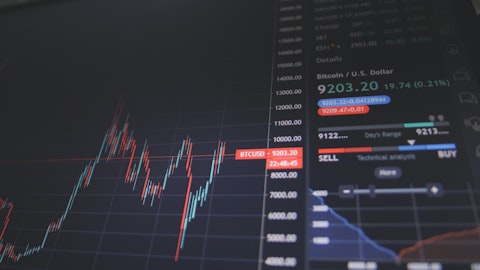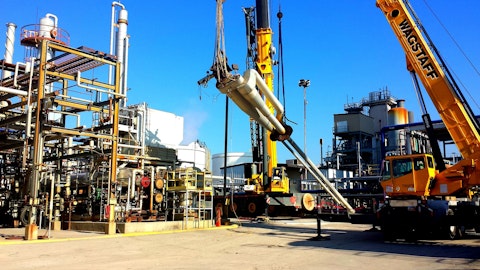Stuart Bodden: Yes. Thanks for the question, Derek. On the first stage pricing, that really is just tied specifically to the plug and perf business or the completions business. So it’s not really impacted by either due to the pump down or the production side. I think as we’ve kind of talked about in the past, on the completion side, it’s been a pretty challenging market. It remains pretty challenging. There are some, I would say, some kind of deals being shopped that might potentially help on the consolidation side, we’ll see if they come to fruition or not. But again, I think on the plug and perf side, we’ve seen the market remain pretty challenged. And truthfully, some of the E&P operators are kind of rebidding a lot of that work to see if they can lock in lower prices. And again, as we’ve said, as a result, we’ve really been kind of focusing our attention more on the more resilient through cycle production type work on the wireline side.
Melissa Cougle: And it’s probably worth mentioning, Derek, we’ve talked a bit in the past about shifting that focus over. I think what you saw in the fourth quarter and what’s continued and we’ve talked about previously, Stuart made a comment about the north region. Remembering the north region really is the bigger business and it has a really outside sort of weather impact. So they start to see significant declines in November and it doesn’t really start to pick back up until late March. We see that phenomenon again this year and so we do feel strongly we are going to be pursuing the pivot. I think that’s that much more difficult to do in the middle of winter. So I think you had sort of an outsized effect, if you will, because you had us sort of saying we’re not chasing the unproductive completions work.
And as we’re trying to sort of pivot over to production and pump down, we’re kind of doing it. We only had a couple of months sort of start at that before we really start to see some winner. So we’re optimistic this year, it’ll probably take a little bit to get off the ground. It’d be fair to say, we probably expect the press to results off a wireline again in Q1, but I think we really are expecting that to pick up here in Q2.
Stuart Bodden: Yes, sure. I’d agree with that.
Derek Podhaizer: And then, I mean, on the margin profile, obviously, it’s bounced around quite a bit over the last few years. I mean is there – do you have a gauge on what you think kind of through cycle margins could look like for this business? I mean I know there’s just been a lot of volatility, but as far as the cost – addressing the cost structure, addressing the right mix of work under the wireline brand, just in order to help us gauge what we – how we should think about margin profile over the next couple of years for wireline.
Stuart Bodden: How we think about it internally, Derek is certainly, we think it’s kind of a north of 15% business is what it ought to be. That’s kind of how we’re modeling it, kind of through cycle. Obviously, a little bit of work to do still to get there, but that’s how we’re thinking about.
Melissa Cougle: And that’s really a blend. I know we probably talked offline production and pump down is closer to 20 completions arguably right now. So the other wild card in that mix is completions is arguably 10 or in some months less. But when you get high productive jobs, you can reach 10% even in completions. We’re just not seeing that lately, given the market dynamics. But I think to Stuart’s point, our [indiscernible] is to kind of get continuously above 10 every month and then we’ll be stretching as we get more and more of our footing and our foundation set on the production business. I think you’ll see that it might take us a couple of years, but I think you’ll see that start to get more resilience and see that there.
Derek Podhaizer: Got it. That’s helpful. Just a final one for me. The outlook for 2024 seems to be softening quite a bit, primarily driven from the weakness in the natural gas basins. But any initial high level takes on how we should think about top line 2024 and EBITDA just where you guys are thinking right now.
Stuart Bodden: I think we’re thinking about a pretty similar year, 2024 being a pretty similar year in total to 2023. As I said in my earlier remarks, Q1 kind of got off to a slow start, but we do have some things in place and we’re kind of optimistic on how things will kind of come together in the back half the year. So again, I mean I think kind of year-over-year it feels – 2024 feels pretty similar to 2023. But again, Q1 is going to be kind of a bit of a slow start.
Melissa Cougle: It’s probably also worth it to mention this year, what Ranger has been able to do in pullback times, we – the last time we saw that in 2021, we pulled off three acquisitions. So I think that that’s getting to be higher on our radar screen as well this year. So we’ll see anybody’s guess. But I think that’s something that’s certainly on our radar screen as well.
Derek Podhaizer: Got it. Thanks for the color. I’ll turn it back.
Stuart Bodden: All right. Appreciate it, Derek.
Operator: The next question comes from John Daniel of Daniel Energy Partners. Please go ahead.
John Daniel: Good morning, Stuart, and Melissa. How are you?
Stuart Bodden: Hey, John. How are you?
John Daniel: I am well. My first question is how would you characterize seller expectations today, just kind of given natural gas weakness and fears of more E&P consolidation and the impact on the business? Have you seen a change today versus maybe a year ago?
Stuart Bodden: I think we’ve definitely seen a change. We’re taking more inbounds than we have in the past. I think we feel like the bid ask is narrowing. I’m not sure it’s all the way there yet, but it does feel like it’s starting to narrow.



